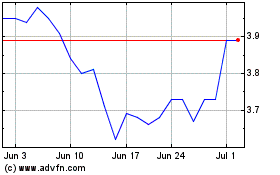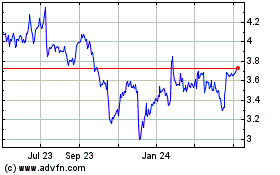By Newley Purnell
NEW DELHI--The hottest phones for the world's next billion users
aren't made by smartphone leaders Samsung Electronics Co. or Apple
Inc. In fact, they aren't even smartphones.
Millions of first-time internet consumers from the Ivory Coast
to India and Indonesia are connecting to the web on a new breed of
device that only costs about $25. The gadgets look like the
inexpensive Nokia Corp. phones that were big about two decades ago.
But these hybrid phones, fueled by inexpensive mobile data, provide
some basic apps and internet access in addition to calling and
texting.
Smart feature phones, as they are known, are one of the
mobile-phone industry's fastest-growing and least-known segments,
providing a simple way for some of the world's poorest people to
enter the internet economy.
While global smartphone sales began sliding last year as markets
became saturated, smart feature phone shipments tripled to around
75 million from 2017, according to research firm Counterpoint. Some
84 million are likely to be shipped this year.
Even as rich nations start to roll out 5G technologies, some 3.4
billion people around the world remain cut off from the internet,
according to We Are Social, another research firm. Most of them
already use traditional, unconnected mobile phones, meaning they
can easily make the transition to similarly shaped devices capable
of high-speed web connections.
Take the case of Kamlesh Kumar, who makes about $80 a month
selling mangoes, avocados and lychees off the sidewalk in New
Delhi.
Two years ago the 35-year-old decided to replace his inexpensive
mobile phone that lacked web access. He couldn't afford even the
cheapest, bare-bones smartphones that cost around $100. So he paid
about $20 for a smart feature phone, called the JioPhone, from
Indian mobile operator Reliance Jio Infocomm Ltd.
Now he listens to Bollywood music on the job, using Google's
built in voice assistant to search for Hindi-language tunes on
YouTube. At night his family crowds around the device to watch
movies.
"I couldn't do anything on my old phone," he said. Mr. Kumar
pays less than $2.50 a month for all the mobile data he needs.
Smart feature phones aren't only inexpensive, but they also have
physical keypads that are less intimidating than touch screens for
those new to the technology. Meanwhile, their batteries last for
days, a bonus in places where electricity is unreliable.
There is a trade-off for the low price. The devices typically
have slower and less powerful components, only basic cameras and
their screens are usually just a few inches in size, factors that
contribute to their longer battery life. There also are fewer apps
available for smart feature phones.
"The demand for reliable and affordable technology continues to
rise" around the world, said Caesar Sengupta, vice president of
Google's Next Billion Users initiative. "Smart feature phones
provide a gateway for the next billion users to more advanced,
affordable technology."
The category was popularized by Reliance Jio, the telecom
company backed by India's richest man, Mukesh Ambani. When its
service started in 2016, executives realized millions of people who
could afford its dirt-cheap data weren't signing up because they
couldn't afford a smartphone.
So the company developed the JioPhone, teaming up with Hong
Kong-based KaiOS Technologies Inc., which makes the most widely
used operating system powering smart feature phones globally. The
software is designed for devices with limited memory and physical
keypads.
Reliance Jio has sold more than 60 million of its devices so far
in India, the only market where they are available.
Recognizing smart feature phones' potential to connect the next
billion users, global tech companies including Facebook Inc. and
its WhatsApp service, Alphabet Inc.'s Google and Twitter Inc. have
tweaked their apps so they can be used on the devices. Last year
Google invested $22 million in KaiOS.
Roughly 370 million smart feature phones will be sold in the
next three years, a $28 billion opportunity for hardware, software
and services companies, Counterpoint says.
That is dwarfed by the market for smartphones, of which 1.5
billion units were sold last year alone. But average smartphone
prices continue to hover at over $300 globally, so they remain out
of reach for many.
French mobile operator Orange SA in recent months has launched
an inexpensive smart feature phone bundled with inexpensive mobile
data plans in the Ivory Coast, Mali, Burkina Faso and Cameroon and
has plans to bring it to other markets in Africa and the Middle
East.
A limited number of smart feature phones are available in
Indonesia and Indonesian manufacturer WizPhone will in a few weeks
begin offering a smart feature phone that can be purchased for
around $7.00. KaiOS is also working with Brazilian smartphone
manufacturers to roll out models there.
While populous developing markets offer the most potential for
the devices' growth since that is where most of the world's next
billion users are located, some companies are pitching similar
gadgets to niche audiences in richer countries.
Finland's HMD Global Oy, which sells Nokia phones, is offering
revamped versions of its popular candy bar-shaped phones, but with
added web access. With price tags nearing $100, their target
audience is enthusiasts of the original devices.
Swedish firm Doro AB launched two KaiOS-powered mobile phones
designed for senior citizens in the U.S. and Europe last year. The
flip phones with large buttons cost between $50 and $150.
"A smartphone can be complex and some people get scared," said
Sebastien Codeville, KaiOS's chief executive.
Vibhuti Agarwal contributed to this article.
Write to Newley Purnell at newley.purnell@wsj.com
(END) Dow Jones Newswires
July 23, 2019 07:14 ET (11:14 GMT)
Copyright (c) 2019 Dow Jones & Company, Inc.
Nokia (NYSE:NOK)
Historical Stock Chart
From Dec 2024 to Jan 2025

Nokia (NYSE:NOK)
Historical Stock Chart
From Jan 2024 to Jan 2025
